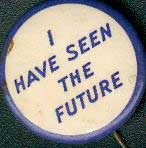 |
|
futurama, autogeddon |
|
Imagining the Superhighway from Bel Geddes to Ballard |
one: introduction
"New communities, new enterprises and new opportunities have
everywhere followed the development of new and better means for
moving goods and people. But progress in transportation -- the
reduction of distance in terms of time and cost -- is, in a larger
sense, only a symbol of expanded horizons in every field of activity."
[2] In this web-essay I argue that Bel Geddes' narrative of the golden future of the Interstate was haunted from the start by a ghost -- the specter of its own death. By the time the Interstate was begun, it was already clear that such a project would have massive material effects on both the natural and the socioeconomic environment. Whole neighborhoods were razed, mountains leveled, wetlands drained, even while the Interstate continued to project forward into a glowing technological future. The Interstate, from the moment of its conception, attempted to use this future-perfect to cover over the ghosts it would leave behind, both human and animal -- the destruction of delicate environments, the ever-present road-kill, the high-speed car smashes. [3] The first section of this essay will investigate optimistic narratives of the highway, using archival materials from the 1939 World's Fair and the beginning of the Interstate building era in the 1950s. These materials represent a vision of the future driven by narratives of progress, civic duty and manifest destiny, often commissioned for the purpose of fulfilling and inciting a demand for consumer goods. The imagined future represented in such ephemera suggests a longing for a perfect, utopian future characterized by technological intervention and social engineering. [4] But the ghosts always come back. In the second section, I argue that a messy, always-under-construction, polluted highway system, beaming cheerfully forward into the future, is reflected back to us in the second half of the century as a degraded landscape in J G Ballard's Crash and The Atrocity Exhibition. In these tales, Bel Geddes' optimistic narrative of the Interstate has collapsed, perhaps under the force of urban decay, but perhaps also because the Interstate system is unsustainable -- both narratively and ecologically. The ghosts of the highway call back to us from these future narratives, reminding us that death is just around the next bend. [5] Jacques Derrida has suggested that ghosts come to talk with us both from the past and the future. Learning to understand these ghosts of the future-past or the past-future is necessary, he claims, if we wish to take responsibility for future generations: [we must] learn to live by learning not how to make conversation with the ghost but how to talk with him, with her, how to let them speak or how to give them back speech, even if it is in oneself, in the other, in the other in oneself: they are always there, specters, even if they do not exist, even if they are no longer, even if they are not yet. (176) In the case of highways, thus, it is important to understand the role that ghosts play in our constructions of the past and the future, if we are to learn to take responsibility for their role in the future. The way we imagine the roads of tomorrow suggests something about the way we value our selves, our environment, and our technologies -- and suggests something about the way we must act, if we are to have responsibility for our future selves. |
| 1 << |
| 2 |
| 3 |
| 4 |
| 5 |
| 6 |
| 7 |
| 8 |
| 9 |
| 10 |
| credits |
| rhizomes |
 [1] In
1939, the General Motors Pavilion at the New York World's Fair unveiled
"Futurama," Norman Bel Geddes' future vision of American transportation.
Futurama consisted of a scale-model America, including a "City of Tomorrow"
and a network of interconnecting fourteen-lane superhighways. These highways
carried upon them ten thousand model cars, which traveled ceaselessly
around the system. Bel Geddes imagined a future in which cars were equipped
with radio transceivers to prevent collision -- the perfect technological
fix to provide a safe environment for the burgeoning traffic on American
roads. Visitors to the pavilion left wearing a lapel pin (above), stating
"I Have Seen the Future."
[1] In
1939, the General Motors Pavilion at the New York World's Fair unveiled
"Futurama," Norman Bel Geddes' future vision of American transportation.
Futurama consisted of a scale-model America, including a "City of Tomorrow"
and a network of interconnecting fourteen-lane superhighways. These highways
carried upon them ten thousand model cars, which traveled ceaselessly
around the system. Bel Geddes imagined a future in which cars were equipped
with radio transceivers to prevent collision -- the perfect technological
fix to provide a safe environment for the burgeoning traffic on American
roads. Visitors to the pavilion left wearing a lapel pin (above), stating
"I Have Seen the Future."